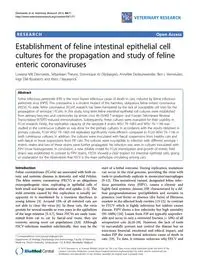
2013 Establishment of feline intestinal epithelial cell cultures for the propagation and study of feline enteric coronav PDF
Preview 2013 Establishment of feline intestinal epithelial cell cultures for the propagation and study of feline enteric coronav
RESEARCH Open Access Establishment of feline intestinal epithelial cell cultures for the propagation and study of feline enteric coronaviruses Lowiese MB Desmarets, Sebastiaan Theuns, Dominique AJ Olyslaegers, Annelike Dedeurwaerder, Ben L Vermeulen, Inge DM Roukaerts and Hans J Nauwynck* Abstract Feline infectious peritonitis (FIP) is the most feared infectious cause of death in cats, induced by feline infectious peritonitis virus (FIPV). This coronavirus is a virulent mutant of the harmless, ubiquitous feline enteric coronavirus (FECV). To date, feline coronavirus (FCoV) research has been hampered by the lack of susceptible cell lines for the propagation of serotype I FCoVs. In this study, long-term feline intestinal epithelial cell cultures were established from primary ileocytes and colonocytes by simian virus 40 (SV40) T-antigen- and human Telomerase Reverse Transcriptase (hTERT)-induced immortalization. Subsequently, these cultures were evaluated for their usability in FCoV research. Firstly, the replication capacity of the serotype II strains WSU 79–1683 and WSU 79–1146 was studied in the continuous cultures as was done for the primary cultures. In accordance with the results obtained in primary cultures, FCoV WSU 79–1683 still replicated significantly more efficient compared to FCoV WSU 79–1146 in both continuous cultures. In addition, the cultures were inoculated with faecal suspensions from healthy cats and with faecal or tissue suspensions from FIP cats. The cultures were susceptible to infection with different serotype I enteric strains and two of these strains were further propagated. No infection was seen in cultures inoculated with FIPV tissue homogenates. In conclusion, a new reliable model for FCoV investigation and growth of enteric field strains was established. In contrast to FIPV strains, FECVs showed a clear tropism for intestinal epithelial cells, giving an explanation for the observation that FECV is the main pathotype circulating among cats. Introduction Feline coronaviruses (FCoVs) are associated with both en- teric and systemic diseases in domestic and wild Felidae. The feline enteric coronavirus (FECV) is an ubiquitous enteropathogenic virus, replicating in epithelial cells of both small and large intestine after oral uptake [1-5]. The mild enteritis caused by this replication is usually un- apparent or is manifested by a transient diarrhoea in young kittens [3]. Around 13% of all infected cats are not able to clear the virus [6]. In these cats, the virus persists for several months or even years in the epithelium of the large intestine [2-5,7]. Since FECVs are easily trans- mitted from cat to cat by faecal-oral route, they are enzootic among most cat populations [3,8]. Although FECV-infections manifest subclinically, they may be the start of a lethal outcome. During replication, mutations can occur in the viral genome, providing the virus with tools to productively replicate in monocytes/macrophages [9-12]. This mutational variant, designated feline infec- tious peritonitis virus (FIPV), causes a chronic and highly fatal systemic disease, FIP, characterized by a dif- fuse pyogranulomatous (peri)phlebitis and serositis in presence (wet form) or absence (dry form) of fibrinous exudate in the affected body cavities [13-15]. In contrast to FECV which is highly infectious but seldom causes disease, FIPV shows a low infectivity but high mortality (95-100%) [16]. Losses from FIP are typically unpredict- able and occur in only a restricted fraction (< 10%) of all seropositive cats [6,16-18]. However, the lack of tools to successfully prevent and control the disease has an enormous financial, emotional and ethical impact, and makes FIP the most feared infectious cause of death in cats [19]. To date, it remains unknown why FECV and * Correspondence:
